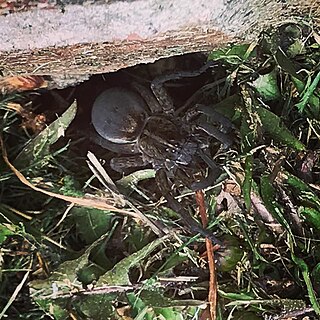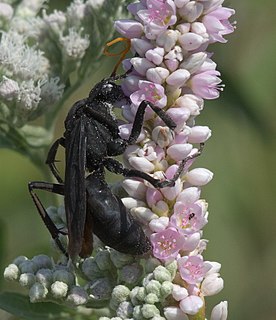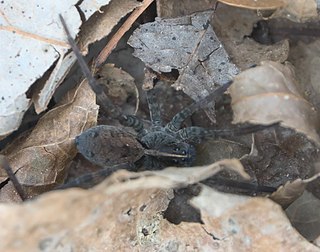
Wolf spiders are members of the family Lycosidae, from the Ancient Greek word "λύκος" meaning "wolf". They are robust and agile hunters with excellent eyesight. They live mostly in solitude and hunt alone, and do not spin webs. Some are opportunistic hunters pouncing upon prey as they find it or even chasing it over short distances. Some wait for passing prey in or near the mouth of a burrow.

The Mygalomorphae, or mygalomorphs, are an infraorder of spiders. The name is derived from the Greek mygalē, meaning "shrew", plus morphē meaning form or shape. An older name for the group is Orthognatha, derived from the orientation of the fangs which point straight down and do not cross each other. In 1802, Charles Athanase Walckenaer separated mygalomorph spiders into a separate genus, Mygale, leaving all other spiders in Aranea.

Huntsman spiders, members of the family Sparassidae, are known by this name because of their speed and mode of hunting. They are also called giant crab spiders because of their size and appearance. Larger species sometimes are referred to as wood spiders, because of their preference for woody places. In southern Africa the genus Palystes are known as rain spiders or lizard-eating spiders. Commonly they are confused with baboon spiders from the Mygalomorphae infraorder, which are not closely related.

Ctenizidae is a small family of medium-sized mygalomorph spiders that construct burrows with a cork-like trapdoor made of soil, vegetation and silk. They may be called trapdoor spiders, as are similar species, such as those of the families Liphistiidae, Barychelidae, Cyrtaucheniidae and some species in Idiopidae and Nemesiidae. In 2018, the family Halonoproctidae was split off from Ctenizidae, leaving only three genera.

The Pholcidae are a family of araneomorph spiders. The family contains over 1,800 pholcids, including those commonly known as the marbled cellar spider , daddy long-legs spider, granddaddy long-legs spider, carpenter spider, daddy long-legger, vibrating spider, gyrating spider, long daddy, and skull spider. The family, first described by Carl Ludwig Koch in 1850, is divided into 94 genera.

Tigrosa aspersa is a large wolf spider that inhabits the eastern United States. Compared to its close relative Tigrosa Helluo, T. aspersa is much larger. This species was known as Hogna aspersa prior to 2012, when the species was moved to Tigrosa.

The Goliath birdeater belongs to the tarantula family Theraphosidae. Found in northern South America, it is the largest spider in the world by mass – 175 g (6.2 oz) – and body length – up to 13 cm (5.1 in) – but it is second to the giant huntsman spider by leg span. It is also called the Goliath bird-eating spider; the practice of calling theraphosids "bird-eating" derives from an early 18th-century copper engraving by Maria Sibylla Merian that shows one eating a hummingbird. Despite the spider's name, it only rarely preys on birds.

Scaffold web spiders (Nesticidae) is a family of araneomorph spiders closely allied with tangle web spiders. Like the "Theridiidae", these spiders have a comb of serrated bristles on the hind tarsi that are used to pull silk bands from the spinnerets. It contains 16 genera and about 300 species, many of which are associated with caves or overhangs. The genus Nesticus is the type for the family and is found throughout the world. The related Eidmannella has speciated considerably in Texas caves and includes some extremely localized species that are considered threatened. One species, Eidmannella pallida, is found in caves and under overhangs, but also in agricultural fields and other habitats away from such restricted areas. The genus Carpathonesticus is found in central Eurasia.
Byrrhodes is a genus of death-watch and spider beetles in the family Ptinidae. There are about 14 described species in Byrrhodes.

Tigrosa is a genus of spiders in the family Lycosidae, found in North America.

Entypus is a genus of spider wasps in the family Pompilidae. There are at least 40 described species in Entypus.

Tigrosa annexa is a species of wolf spider (Lycosidae) native to eastern North America from Texas, east to Florida, and north to Ohio.

Tigrosa georgicola is a species of wolf spider in the family Lycosidae. It is endemic to the Southeastern United States. The type specimen was collected in Burke County, Georgia. Its habitat includes the forest floor of deciduous woodlands.

Helophorus grandis is a species of water scavenger beetle in the family Hydrophilidae. It is found in Africa, Europe, Northern Asia, and North America.
Steatoda grandis is a species of cobweb spider in the family Theridiidae. It is found in the United States.












